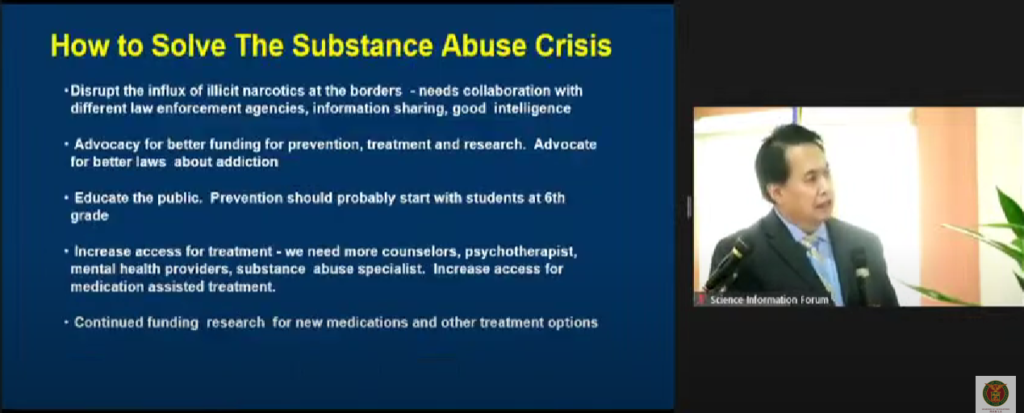“Substance use disorder is a cluster of cognitive, behavioral, and physiological symptoms that should be treated like any other illness”
April 27, 2023 — “Every country is trying to solve the drug problem and what we want is to cut down the supply. We don’t have to kill them [the users], we just have to offer treatment,” Dr. Jose David, specialist in addiction medicine, said in a forum organized by the University of the Philippines Manila (UPM), Asian Drug Policy Center (ADPC), and the National Academy of Science and Technology (NAST).
The clinical professor who treats patients with substance use disorder reported ten classes of drugs: alcohol, caffeine, cannabis, hallucinogens, inhalants, opioids, sedatives-hypnotics, anxiolytics, stimulants, and tobacco.
Synthetic drugs or “designer drugs” are also starting to emerge and are increasingly being abused. These are made by “street pharmacists” who find potent derivatives and concoct them in clandestine laboratories.
A comprehensive list of emerging drugs of abuse were discussed during the forum including the following:
Photo illustration of 2 milligrams of Fentanyl, a lethal dose. Courtesy: U.S. Drug Enforcement Agency.
Fentanyl. A synthetic opioid that only takes two milligrams for a fatal dose is 50 times more potent than heroin; and 100 times more potent than morphine. It is found to be one of the most detected substances among the overdose deaths in 2022.
Synthetic cathinones. It is commonly referred to as bath salts and mimics the effects of methamphetamine (crystal meth) or the party drug ecstasy. It causes a 950% increase in serotonin and a 500% increase in dopamine. Its side effects include extreme paranoia, delusions, hallucinations, nausea, vomiting, seizures, tachycardia, hypertension, anxiety, agitation, and death.
“This drug can make you so paranoid that a bath salt abuser ate a man’s face,” said Dr. David.

Synthetic cannabinoids. Also known as “K2”, it serves as an alternative to achieve euphoric effects similar to marjiuana. It contains dried and shredded plant material sprayed with chemical additives for psychoactive effects. It is legal in some states in the US and is usually sold at convenience stores with the label “not for human consumption”.

Desomorphine. This is also known by the street names: “Krokodil”, “Poor Man’s Heroin”, or “Zombie drug”. It is a cheaper alternative to heroin that causes skin ulcerations, infections, and gangrene-discolored scales in long-term users. Krokodil may contain unknown ingredients making it extremely harmful and lethal.

According to Dr. David, almost 80% of those who abuse substances struggle with mental health issues; and evidence-based treatment has been shown to speed up recovery and minimize adverse effects of addiction such as HIV and overdose deaths.
“Substance use disorder is a cluster of cognitive, behavioral, and physiological symptoms that should be treated like any other illness,” Dr. David stated. To address the crisis of addiction, he called for government agencies to collaborate, educate young children about the harms of illegal substances, and provide better funding for research and rehabilitation.
Medical experts and representatives of key government units resonated with these messages. “We can only succeed if we don’t operate in silos,” said Dr. Leonardo Estactio, professor of the College of Arts and Sciences
Department of Behavioral Sciences at UP Manila. “We should work together to be able to confront the substance abuse crisis.”
Ms. Rebecca Arambulo stated that the Dangerous Drugs Board “will emphasize more on the drug demand reduction and the treatment” and at the same time will adopt a compassionate approach to victims of drug use by encouraging voluntary treatment and rehabilitation.
Dr. Jose Pascual, head of the Division of Addiction Medicine of the Philippine General Hospital (PGH), called for increased training in addiction medicine for physicians, nurses, and allied professionals in the country in order to bridge the treatment gaps.
Other highlights from the forum are the following:
The substance abuse helpline 1550 of the Department of Health (DOH) is available from Monday to Friday, from 8 a.m. to 5 p.m., and is accessible by landline or mobile phone. Hotline operators can provide brief assessments, intervention services, and referrals for treatments.
Watch the forum in full. | Anne Marie D. Alto